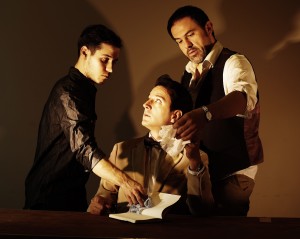Who Will Wear Lorca’s Bowtie?
The ghost of Federico Garcia Lorca is wandering the stage of The Duke theater on New York’s 42nd Street this December and he’s not quiet. AENY-El Puente, Spanish Artists in New York, with the support of the Consulate General of Spain in New York and the Spanish Embassy, have resurrected the famed poet and dramatist in all his dark and dazzling glory.
Wearing Lorca’s Bowtie, a world premiere first production for the company, is described in the program as a “theatrical experiment,” inspired by Lorca’s nine months in New York City in 1929. This sojourn, a spiritual eternity away from Lorca’s beloved Madrid, is at the heart of the company’s multi-disciplinary production. Such an “experiment” could more aptly be called a free-wheeling extravaganza for the senses. Discordant sounds fill the ears. Blood red lighting assails the eyes. Bodies alternately cavort and collide across a mostly bare stage, signaling the brash intervention of the city at every turn. But where is Lorca in all this?
Evidently he is everywhere, and at the same time, nowhere.
Lorca, the young poet, is gracefully incarnate in Sebastian Galvez’s performance; bombastic and jaded in the older Juan Carlos Lopez’s turn; then tremulous and terrified in Soraya Padrao’s transformative, androgynous portrayal. It’s a risky directorial choice, at times confusing to the audience perhaps, but one that feels ultimately right. A Poet In New York became the revolutionary collection of poems that Lorca produced during his stay and in his own words, he sees himself walking the streets and alleyways, an artistic voyeur “bumping into my own face, different each day, cut down by the sky!”
And what of the bowtie in the play’s title? As the troupe moves in and out of each others lives in a crazy, choreographed dance, they change characters as deftly as they change clothes. The crimson bowtie (Lorca’s own signature piece of apparel), is passed from actor to actor, taking on a life of its own and becoming a striking symbol of cohesion and destruction.
How did this surrealistic enterprise—at times comical, at times chilling—make it on the boards?
According to co-director Josh Hecht, the project started with a three-week workshop in October.
“Before the story there was a series of vignettes that we created that came out of the entire group’s various interests in Lorca, impressions of what 1920s Spain and New York must have been like that we carried with us,” he said.
He explained that one of the most challenging aspects was figuring out how this ensemble of actors, a community of Spanish actors, dancers and musicians migrating to New York, not unlike Lorca himself, could coalesce into a real company.
Out of this huge collage of impressions, Hecht and writer Mar Gomez Glez developed the storyline of the piece, careful not to hammer it into a linear narrative. Instead, Hecht said they asked, “What is the container that can hold all these different impressions?”
Historically, Lorca’s life was a tempestuous and tragic one. His young years in Spain were filled with ambition and love for Spanish folklore and gypsy romances. An early passionate friendship with Salvadore Dali and exposure to the work of Luis Bunuel gave his writings a definite surrealist bent. During his stay in New York he studied and lectured at Columbia University, but ventured in desperation into the city’s underbelly of faceless hustlers, which became a journey of lost faith. After his return to Spain in 1936, at the outbreak of the Civil War, he was arrested and subsequently assassinated. During Franco’s reign his books were burned, and to this day, no one knows where his body rests.
Ignacio Garcia-Bustelo, a co-director and founding member of AENY, did not, however, want to focus on the historical aspect of Lorca’s life.
“We wanted the piece to reflect our own questions and concerns. We are using Lorca as a lens, to explore loneliness and knowing other people,” he stated.
The play’s set design, by Robin Vest, utilizes two tall multi-level grids as fire escapes and squalid bedrooms, allowing the performers’ lives to brilliantly intersect. The lighting by Clifton Taylor and the stark costuming by Yuko Nakao blend beautifully, and the haunting interplay of composer Javier Moreno’s jazz-infused music gives the overall production an almost seamless fluidity.
To Garcia-Bustelo’s credit, the choice was made to eliminate any overtones of flamenco in the score. “It has been done so many times. That part of Lorca is explored so often, I wanted to get away from it, to find other sides of Lorca, more risky, for this production.”
For the most part, these talented and adventurous directors succeed in their efforts. A standout moment in the production, and there are several, takes place during a masked party. In a moving incarnation of Lorca, actress Maria Cuartero is tempted by the advances of several men and women, until the game becomes dangerous and destructive. In another lighter vignette, David Riley plays an American tour guide, and Spanish and English overlap at lightning speed until the whole enterprise collapses into a hysterical Tower of Babel. The free-flowing use of the Spanish tongue throughout could have been disastrous for many audiences in a wordier, plot-filled script, but in this instance, the emotive power of the play is strong enough to overrule this concern.
The only strident note is a weighty polemic against capitalism delivered by actress Freia Canals. Passionate as her delivery is, it is overlong and could benefit from some judicious cutting. Lorca witnessed the crash of 1929 and fragments of his writing have been used by the organizers of Occupy Wall Street to good effect.
Thanks to AENY’s excellent “experiment,” Lorca’s ghost is alive and well not only at the Duke on 42nd Street, but on the streets of New York.


